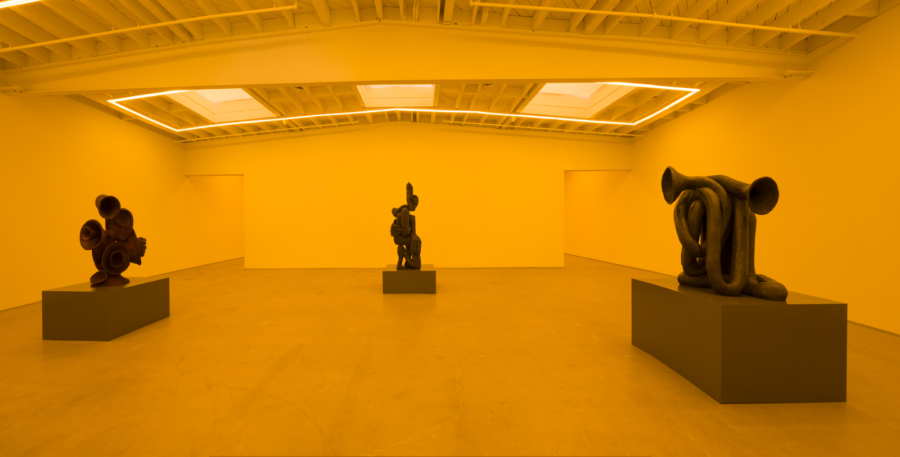February 1980
Download as PDF
View on Artforum
If nothing else, ALAN SARET continues to reinvigorate the sculptural notion of drawing in space. Here, for example, all but one of the seven wire clusters being shown suspended from the ceiling seem immutably whole, correct and passionately beautiful. However, Saret aspires to much more than formal accomplishment. He is seeking to infuse his work with spirituality and he nearly succeeds. The one weak piece, A B White Among Black Permutation Clusters, resembles a shrunken head and introduces the problem of anthropomorphism and, by extension, of ego. Otherwise, where he substitutes intuition for logic, he is incomparable.
Sculpture, itself, is often laden with any number of technical requirements which at once limit its expressive options and make legitimate, however briefly, witless virtuosity. Its repertoire of materials and, to some extent, its scale are rooted in certain ambient periods. Steel assemblages of human size recall the ’50s, whereas ignoble materials, closely ordered or jumbled, advertise themselves as mid-to-late-’60s handiwork. Plywood and 2x4s in any kind of domestic configuration will pass henceforth as a ’70s stereotype. Within this simplistic analysis of the medium, anomalous visionaries appear: Smithson certainly, de Maria perhaps. Saret could well be of their caliber.
His work embodies an entropic, anti-formal comprehension of art that is common to much of the best work of the generation of sculptors born in the 1940s, from Serra to Benglis. But Saret. in his deliberate turning away from mass, either in reforming it as art (the Earthworks ethos) or from joining it together in unlikely, effective ways (Constructivism), distinguishes both his method and his product. That was definitely my impression last summer when faced with his 6 foot high folded chicken wire construction in the Museum of Modern Art’s sculpture collection show. The piece’s kinship with Rodin’s Balzac was striking.
Saret is probably the only artist of our time who has made sense of and peace with ecology. He successfully harnesses and transforms the inchoate back-to-the-earth instinct of the past fifteen years without reverting to the artist-as-Luddite stance that invalidates a whole gang of mud daubers, rock scrapers,and cave builders. Some undated notes from Saret’s notebooks, that Michael Auping quoted in a brochure for his Matrix exhibition at the University Art Museum, Berkeley, affirm Saret’s profound symbiosis with his work. He wrote, “The flexure of each material draws a line in space which corresponds identically to its physical properties. Nature, therefore, draws the final line in art.” This cooperation is so unaffected and complete that Saret can fashion an amorphous clot of red- and green-coated wires into a remarkably evocative metaphor for walking in nature, or so I see in Green and Scarlet Mountain Triumph Permutation Cluster Cloud.
Every color and thickness of wire in these pieces can be decoded for specific and symbolic meaning. For all their seeming randomness, I suspect their litheness comes from discipline. Saret knows what he is about. His fervor, allied as it is with a greater force, has helped him avoid the morass of contrived expressionism that can so easily consume this kind of slightly mad, completely inspired art.



